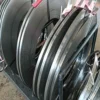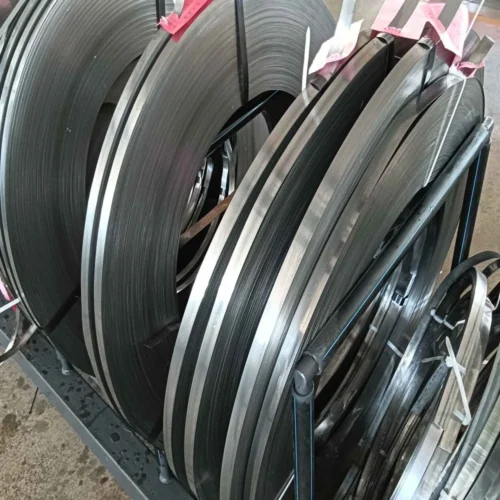2205, S32205, 1.4462 spring stainless steel strip
2205, S32205, 1.4462 is a duplex (austenitic-ferritic) stainless spring steel with very good spring properties and excellent corrosion resistance. 2205, S32205, 1.4462 is characterized by:
- Very good spring properties and fatigue resistance
- High resistance to stress corrosion cracking (SCC) in chloride-containing environments
- High resistance to general corrosion, pitting and crevice corrosion
- High tensile strength
- High modulus of elasticity
Service temperature: – 100 to 300 °C (-150 to 570 °F)
Standards
- UNS: S32205, S31803
- EN Number: 1.4462
- EN Name: X 2 CrNiMo 22-5-3
Chemical composition (nominal)
Chemical composition (nominal) %
| C | Si | Mn | P | S | Cr | Ni | Mo | N |
| 0.030 | 0.5 | 0.9 | ≤0.030 | ≤0.015 | 22 | 5 | 3.2 | 0.18 |
Applications
Due to the unique combination of excellent spring properties and high resistance to corrosion, 2205, S32205, 1.4462 can advantageously replace ASTM 301, 17-7PH or coated carbon steel in the form of springs, coil springs, spring washers, hose clamps, etc. where heavy demands are made on the resistance to corrosion attack in many industrial applications, such as:
- Automotive
- Food
- Oil & Gas
- Chemical
- Pulp & Paper
- Marine & Shipping
Corrosion resistance
In most media, 2205, S32205, 1.4462 possesses better resistance to general corrosion than steel of type ASTM 316L. For details please refer to Alleima Corrosion Handbook.
Pitting
The pitting resistance of stainless steel is determined primarily by its chromium and molybdenum contents, but also by its nitrogen content. A parameter for comparing the resistance of different steels to pitting is the PRE number (Pitting Resistance Equivalent).
The PRE is defined as, in weight-%:
PRE = % Cr + 3.3 x % Mo + 16 x % N
The PRE numbers for 2205, S32205, 1.4462 and two standard materials are given in the following table.
| Grade | % Cr | % Mo | % N | PRE |
| 2205, S32205, 1.4462 | 22 | 3.2 | 0.18 | >35 |
| ASTM 316L | 17 | 2.2 | – | Approx. 24 |
| ASTM 301/304 | 18 | – | – | Approx. 18 |
The ranking given by the PRE number has been confirmed in laboratory tests. This ranking can generally be used to predict the performance of an alloy in chloride containing environments.
Laboratory determinations of critical temperatures for the initiation of pitting (CPT) at different chloride contents are shown in figure 3. The chosen testing conditions have yielded results that agree closely with practical experience.
2205, S32205, 1.4462 can be used at considerably higher temperatures and chloride contents than ASTM 301/304 and ASTM 316 without pitting. It is, therefore, far more serviceable in chloride-bearing environments than standard austenitic steels.
Crevice corrosion
Crevice corrosion is a similar phenomenon as pitting corrosion, but occurs in crevices and cracks, e.g. between assembled parts or under deposits on the metal. Crevice corrosion often occurs at lower temperatures and at lower chloride contents than those necessary for pitting to occur. Resistance is influenced by the content of Cr, Mo and N, in the same way as pitting resistance. 2205, S32205, 1.4462 offers considerable better resistance to crevice corrosion compared to standard austenitic steels like ASTM 301 (EN 1.4310) and ASTM 316L (EN 1.4404).
Stress corrosion cracking
Standard austenitic steels of the ASTM 301/304 and ASTM 316L types are prone to stress corrosion cracking (SCC) in chloride-bearing solutions at temperatures above 60°C (140°F).
Duplex stainless steels are far less prone to this type of corrosion. Laboratory tests have shown the good resistance to stress corrosion cracking of 2205, S32205, 1.4462. Results from these tests are presented in Figure 5. The diagram indicates the temperature-chloride range within which 2205, S32205, 1.4462 shows superior resistance to SSCS compared with standard steels ASTM 301/304 and ASTM 316L.
Figure 5. Resistance to stress corrosion cracking, laboratory results for Springflex of constant load specimens loaded to 85% of the proof strength at the test temperature.
Bending
The values given below have been obtained by bending according to Swedish standard SS 11 26 26 method 3 (in a 90° V-block with a 25 mm die opening, a sample of 35 mm width, turned so that the burrs of the blanked edges face into the bend). They can be used as guidance for the smallest recommended bending radius.
| Nominal tensile strength, Rm | Thickness, t | Min. bending radius as function of thickness *) | |
| MPa | mm | ⊥ | // |
| 1300 | 0.25 | <0.5 t | 3 t |
| 1300 | 0.50 | t | 4 t |
| 1500 | 0.25 | t | 4 t |
| 1500 | 0.50 | 2 t | 10 t |
| 1700 | 0.25 | 1.5 t | 6.5 t |
| 1700 | 0.50 | 3 t | 10 t |
| 1900 | 0.25 | 2.5 t | 10 t |
∗) ⊥ Bend transverse to the rolling direction
// Bend parallel to the rolling direction
Forms of supply
2205, S32205, 1.4462 is supplied, as standard, in the cold rolled condition. Strip steel can be supplied in coils, bundles, on plastic spools or in lengths. The edges can be slit, deburred or smoothly rounded. Contact us for more information.
The following range of thicknesses and widths can be supplied as standard.
Dimensions
| Thickness, mm | Width, mm | Thickness, in | Width, in |
| 0.03 – 3.5* | 2 – 300 | 0.0012 – 0.14 | 0.079 – 12 |
*Depending on requested tensile strength.
Tolerances
The thickness and width tolerances are +/- tolerances to the nominal size. The normal tolerance classes for most of our strip products are T2 and B1. Tighter tolerances as well as other tolerance limits can be offered upon request.
Heat treatment
The strength of cold rolled 2205, S32205, 1.4462 can be increased by a tempering operation at 450°C (840°F) for 1 hour. An increase in tensile strength of approx. 200 to 350 MPa can be expected, depending on the initial cold rolled tensile strength. Further information on the nominal tempering effect can be seen under the “Mechanical properties” section. This heat treatment is also beneficial for relaxation and fatigue resistance.
Tempering is normally carried out after forming of the parts.
Tempering in open air furnaces gives a brownish oxide on the surface and can have a negative impact on the corrosion resistance. For applications where the corrosion resistance is critical, it is recommended to perform the tempering in protective gas, or to use parts in the untempered condition. Alternatively post-tempering treatment by pickling and/or tumbling can be performed. Contact Alleima for further recommendations.
Mechanical properties
Static strength, nominal values
| Condition1) | Tensile strength, Rm | Proof strength, Rp0.2a) | Elongation, A11.3 | ||
| MPa | ksi | MPa | ksi | % | |
| C | 1100 | 160 | 1000 | 145 | 18 |
| CT | 1200 | 174 | 1150 | 167 | 10 |
| C | 1300 | 188 | 1200 | 174 | 5 |
| CT | 1500 | 217 | 1450 | 210 | 4 |
| C | 1500 | 218 | 1375 | 199 | 4 |
| CT | 1700 | 247 | 1650 | 239 | 3 |
| C | 1700 | 247 | 1600 | 232 | 3 |
| CT | 2000 | 290 | 1950 | 283 | 2 |
| C | 1900 | 276 | 1700 | 247 | 2 |
| CT | 2200 | 319 | 2000 | 290 | 2 |
1) C = Cold rolled, CT = Cold rolled and tempered, 450 °C (840 °F)/1h. Refer to section ‘Heat treatment’.
a) Rp0.2 corresponds to 0.2% offset yield strength.
1 MPa = 1 N/mm2
Fatigue strength
Nominal values at 20 °C (68 °F) in a normal dry atmosphere. The fatigue limit is defined as the stress at which 50% of the specimens withstand a minimum of 2 million load cycles.
Reversed bending stress
Average stress = 0
Bending transversal to rolling direction.
| Tensile strength, Rm | Fatigue limit | Tensile strength, Rm | Fatigue limit |
| MPa | MPa | ksi | ksi |
| 1600 | ±615 | 232 | ±89 |
*Measured on strip in thickness 0.50 mm (0.020 in).
Relaxation
Relaxation testing of 2205, S32205, 1.4462 shows better relaxation properties than for austenitic grades at comparable tensile strength levels. The figure shows the relaxation (load loss) at room temperature as a function of time for Springflex in the tempered condition compared to standard spring grades 17-7PH (EN 1.4568) and ASTM 301 (EN 1.4310).
Physical properties
The values refer to cold rolled material, at a temperature of 20°C (68°F) unless otherwise stated.
Density 7.8 g/cm3 (0.28 lb/in3)
Thermal conductivity
| Temperature, °C | W/m °C | Temperature, °F | Btu/ft h °F |
| 20 | 14 | 68 | 8 |
| 100 | 16 | 200 | 9 |
| 300 | 19 | 600 | 11 |
Specific heat capacity
500 J/kg °C (in the temperature range 50 – 100°C)
Thermal expansion mean values in temperature ranges (x10-6)
| Temperature, °C | per °C | Temperature, °F | per °F |
| 20 – 100 | 13 | 68 – 200 | 7 |
| 20 – 200 | 13.5 | 68 – 400 | 7.5 |
| 20 – 300 | 14 | 68 – 550 | 8 |
Resistivity
| Temperature, °C | µΩm | Temperature, °F | µΩinch |
| 20 | 0.74 | 68 | 29 |
| 100 | 0.85 | 200 | 33 |
| 200 | 0.96 | 400 | 38 |
| 300 | 1.0 | 600 | 40 |
Modulus of elasticity
Cold rolled, C: approx. 200 000 MPa (29 000 ksi)
Cold rolled and tempered, CT: approx. 210 000 MPa (30 400 ksi)
For cold rolled and tempered condition, the modulus of elasticity shows a high and almost constant value up to loads of about 70% of the yield strength, as shown in figure 2. For comparison, similar values for grades 17-7PH (EN 1.4568) and ASTM 301 (EN 1.4310) spring steels are added.
- Modulus of Elasticity, E, as a function of applied stress. Springflex compared with 17-7PH and ASTM 301.











